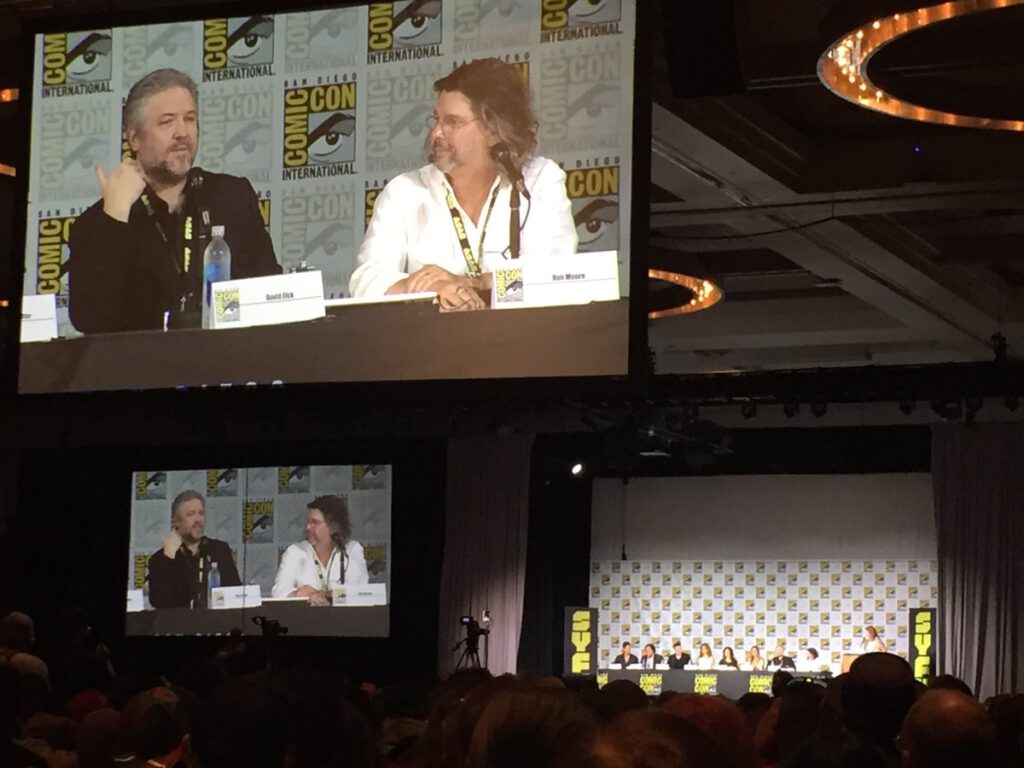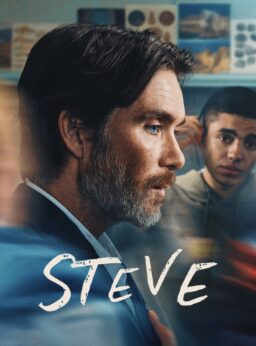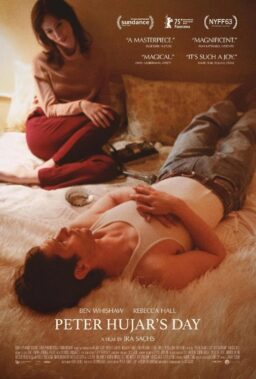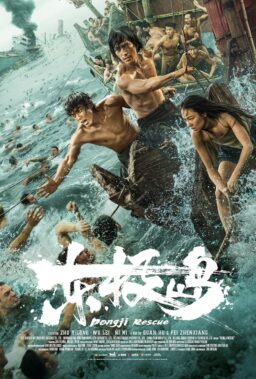In the all too brief 10-minute round table following the “Battlestar Galactica” Reunion, I was seated next to David Eick who, with screenwriter Ronald D. Moore, reimagined the 1978 TV series and controversially changed Starbuck and Boomer into female characters but also made room for the return of the original Apollo, Richard Hatch, as the political terrorist Tom Zarek. Eick dispelled one mystery, but left me with another to followup after SDCC.
Moore noted that he had fond memories of “three places that I felt like I lived in during the show” which were in pre-production where he argued, laughed and cried in the writers room, in production where he loitered outside of sound stage smoking with James Callis (Dr. Gaius Baltar) and in post-production where he was in the cutting room with Eick “arguing about ‘Is the show too long?’” and what shots were necessary. The reimagining of “Battlestar Galactica” ran from 2004 to 2009.
For Eick, Battlestar represented a profound change in his professional trajectory. “Ron was pretty instrumental in forcing me to start writing. When we were doing the show, I was a non-writing producer until ‘Battlestar’ and I transitioned my entire career to a writer/producer from ‘Battlestar.’ I used to give Ron voluminous notes.” Moore finally asked why don’t you just write it yourself and “and finally I did and that’s become what I do. On a personal level, it was a sign that someone was taking stock in me. On a professional level, it represented a big move forward.”
When asked what was the most interesting fan experience, Eick recalled, “There was the guy that pulled up to the Universal lot and my bungalow was there that said he was the illegitimate son of Glen Larson (creator of the original series) and wanted to meet David Eick and he was African American and Larson is not. So they had to do that math and they had to wonder what the connection to me was.” The police were called, but Eick said, “I got the call from the security office that a man came here looking for you wanting an explanation from ‘Battlestar Galactica.’”
There are explanations that more sane fans have wanted. In the Syfy’s version of “Battlestar” the Cylons were created by man and they had a plan. ”But just what was that plan? Moore admitted at the ATX reunion panel last month there was no plan.
When asked for details, Eick quickly shut down Moore and proceeded to explain how Disneyland martinis influenced Season 3. “We get done with season 2 of ‘Battlestar,”—20 episodes, Season 1 was 13. Twenty episodes mowed his [Moore’s] ass. We go to Disneyland and because we’re going to break season 3 at Disneyland, we’re standing in line at Space Mountain at 11 in the morning. We have tickets for Club 33 which is the only place in Disneyland where you can drink and we’re like: ‘It’s 11 o’clock; fuck Space Mountain. Let’s go get a drink.’ We go and sit down.” According to Eick, Moore was adamantly declaring he wasn’t going to do another season and that he couldn’t do another season, but between the buffet and more martinis, they came up with the idea of going on to the Cylon ships. “There was a plan; we just didn’t know what it was.”
With that explanation, Eick and Moore left the table, but Eick left me with a mystery less complicated than Cylon plans for mankind. While Moore had been talking about his “Outlander” series, Eick had looked up and shown me a January 26, 1999 blog essay that Roger Ebert had written: “At Sundance, Hopeful Directors Will Do Anything for a Break.” After glancing at it, I promised to read it later, not wanting to interrupt or hijack the round table.
The blog entry was about a 22-year-old man in a goose-down parka, Stuart Acher, who succeeds in partially showing Roger his 20-minute Boston University thesis project, “Bobby Loves Mangos,” Roger described the movie as “a fascinating premise, and it develops like ‘Twilight Zone: The Movie’ meets ‘Groundhog Day.’” Roger was on his way to a screening and rushed off, but after the screening, Roger bumped into Eick, then senior vice president of the USA Networkand introduced Acher to Eick, leaving the two at the Yarrow Inn coffee shop. “The kid talks the manager into putting the film back on the TV again. As I leave, Eick is watching it, with Acher right next to him.”
The essay ends with questions about Acher’s fate. A quick search on IMDb indicates that Acher worked last year as an editor for the TV series “Guiding Alaska” (six episodes) and “Z Nation” (two episodes). This year, he produced a TV movie “Eyewitness” and is in post-production for “The Morning After,” a movie that he directed and produced which is scheduled for release in 2018.
In an email exchange, Acher remembered that Eick watched the full 20-minute short and “he said extremely complimentary words.” While Eick was not directly responsible for the DreamWorks deal (which eventually fell through), “the whole momentum of the article by Ebert, as well as the followup articles garnered me all sorts of attention. Whether it was deserved, I don’t know… but It was like lightning in a bottle.
On Roger, Acher commented, “He was the match that lit the blaze for me. More often than not I think about how grateful I am for his support.I grew up watching Roger with Gene Siskel and later with Roeper. It was always a dream of mine to have him review my first feature. And when #Stuck was ready for the worId, I sent him a copy. However as the cards fell, it was right when his health was deteriorating. I don’t know if he ever saw it, but his last email to me suggested he was going to watch it just a few days before he passed.
“I’d like to think he would have appreciated it. We emailed our mutual appreciation of characters who spewed witty dialogue and I believe that resonated when writing #Stuck.”
Sometimes stubborn determination pays off, in ways you can’t imagine. Sometimes, you don’t know how people you know are connected and where those connections lead. On that particular Thursday in San Diego, I went from “Battlestar Galactica” to Sundance and back to a place of hope about random acts of kindness.
(Photo at top by Tracy Brown / Los Angeles Times)












